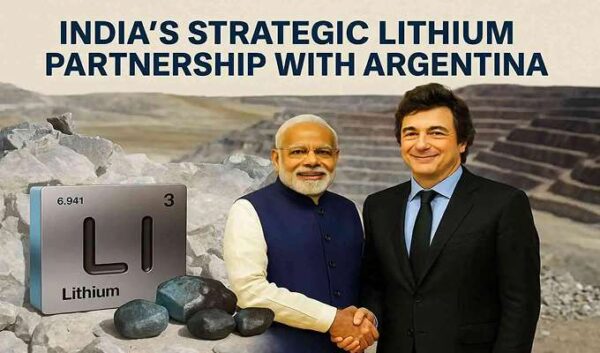India is developing its strategic footprint in South America’s Lithium Triangle, with Argentina, Bolivia and Chile, as it looks to pursue minerals security in the long term while embracing its clean energy transition. Argentina has become an important partner for India in trying to obtain its critical mineral supply in support of the future electrification and green technologies.
Why is Lithium Important?
In an increasingly electrified world, lithium is emerging as the “new white gold.” Lithium is used in batteries that power electric vehicles (EVs), consumer electronics, renewables storage systems, drones, and even defence technologies. As worldwide demand for lithium is expected to grow, nations are competing to secure stable and diversified supplies for this critical mineral.
India’s current lithium imports are largely 80% sourced from China. Considering the source of where lithium comes from raises concerns because India does not want an over-dependence on one country. While reducing overreliance on any single country is an important factor in India’s mineral security transition, it is also important for India’s expanded leverage in global diplomacy and trade. Since lithium will be an important component for the economy of the future, it is reasonable to use this new partnership with Argentina as a model for India’s green transition.
India has located lithium, especially in the regions of Jammu & Kashmir and Karnataka; yet, it does not have sufficient advanced technology to mine and refine lithium. Hence, India’s deal with Argentina is not just about raw materials, it is also about the critical know-how. Countries are often partners with one another for knowledge sharing, for instance, through extended technology transfers, shared research partnerships and sustainable mining in India.
Khanij Bidesh India Limited (KABIL), a public sector enterprise has finalised five concession agreements with CAMSAY, the Argentine state enterprise undertaking lithium exploration and development. These five concession agreements are an important milestone in India’s mineral diplomacy and illustrate the growing maturity of India’s international resource strategy.
Argentina is part of the Lithium Triangle, which has over 50% of located lithium reserves globally. Among the triangle countries Argentina has the second-largest lithium reserves and is ramping up production. In this initial step, India is guaranteeing a presence in one of the most resource gravitating regions for lithium (an obvious advantage in the global race for a clean energy future).
Geopolitically, the development is equally noteworthy. China currently has around 60% of lithium refining capacity globally and has control over the supply chain of other critical minerals. In response, the United States started the Mineral Security Partnership (MSP) in a bid to reduce reliance on Chinese supplies. India is part of the MSP, and it conduces to India taking advantage of critical mineral access and technology sharing amongst democratic partners in the future.
South-South Cooperation and Civilizational Ties
India and Argentina have an excellent basis for South-South Cooperation, which seeks to promote solidarity and support amongst developing countries. India and Argentina enjoy civilizational connections in addition to trade, linking them through mutual respect and a common vision for sustainable growth and development. As Prime Minister Narendra Modi prepares for an official visit to Argentina (the first visit by an Indian PM to Argentina in 57 years), it demonstrates the increasing importance of this relationship, and to create more cooperation in these sectors including in minerals and clean energy, high-tech innovations.
Why are they called “critical” minerals?
Lithium, to use just one example, has become a critical mineral because of its dependency on modern technology. Meanwhile, when it comes to innovation, we currently have a supply chain of minerals which are essential like mining lithium for smartphones, electric vehicles, medical devices, military hardware, etc. Any disruption to the supply chain could result in consequences as far reaching as national security, not to mention the mounting toll it could take on economic progress and industrial production.
This lithium arrangement is a compelling example of India’s interest-based and pragmatic foreign policy, integrating economic aims with technological progress and a diplomatic strategy. By gaining access to Argentina’s lithium reserves and forming a conduit for other technology transfers, India is laying the foundation of being a progressive global actor in clean tech and strategic resource management. In the next twenty years, this framework could influence the energy environment of both India and the wider developing world.

